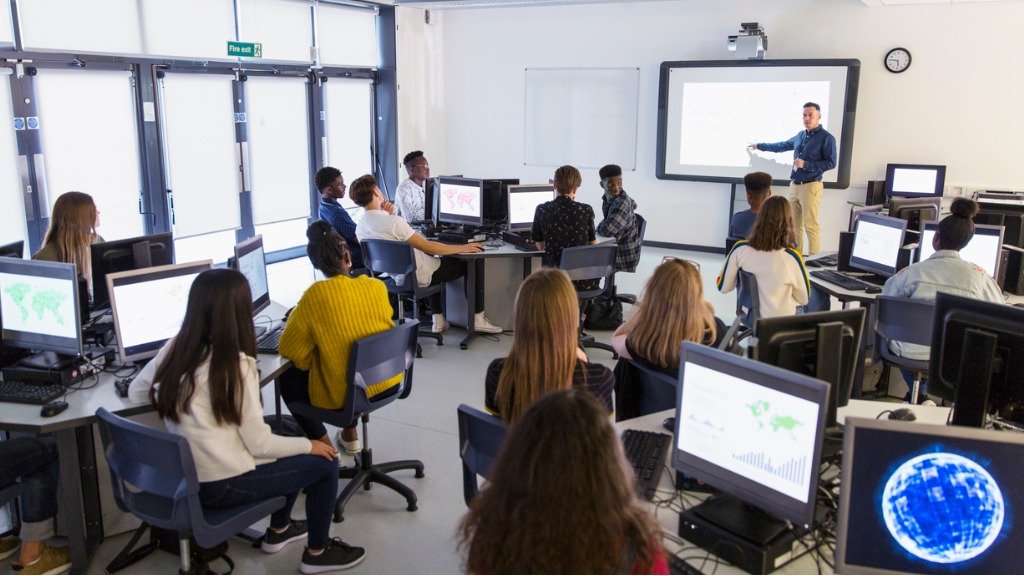The Best Of The Best: What Makes An Educational Experience Special?

Project Managers. Scrum Masters. MBAs. Project managers spend serious time in classrooms. Be they virtual or live, the quality of educational experiences ranges from the pathetic to the sublime. Project Manager Today interviewed a number of project managers to try to refine what makes for the ideal educational experience.
Rachna Singh from Wells Fargo says her best educational experience was training for the Certified Scrum Professional. “It was a complete working session for two days filled with loads of energy across the days.” She says, “The way it was conducted by the trainer, without a presentation, mere working session made the overall learning exemplary.”
Nathan Subramaniam, MBA, ITIL v3 Expert® TOGAF 9.1 Certified® PMP® ACP® RMP® ICP® CSM® SA® eTOM Level 2®, COBIT 5® CMMI Associate®, CLSSMBB, has made a career of gaining certifications. Each one requires some level of training. In his work as a Business Architect with Universal Service Administrative Company, he’s had ample opportunity to evaluate training experiences.
His favorite? “I would say the ITIL “Managing across the Lifecycle” training Class leading up to the ITIL v3 Expert certification. This is one course that I could not wait t to sink my teeth into as I was ready to immediately put to use what I learned to address real workplace issues.”
In his experience, a lot of the quality of the educational experience hinged on the participants, rather than the instructor. “This training was unique mainly because the candidates that are qualified to attend this class are seasoned professionals who have “persevered” having gone thru the rigor of ALL the ITIL Intermediate classes.
Needless to say, it was a level playing field. The diverse representation of professional backgrounds in the student body and exchange of rich information enhanced the breadth and depth of classroom discussions.”
The shared experience seems to be a factor both in the classroom and on the breaks. “They provided a full experience,” says Plantronics program manager Juliano Esposito Muniz. He said the experience From “the moment you enrolled until the last minute you left the course.
They made some meetings after class to everyone meets each other and the lunch was served inside the building, it means we worked together, eat together and share knowledge and experience. He says the Berkley Product Management training was a great blend of facility, instructors and content.
For Rehan Baaqri, Head of Business PMO, AvisBudgetGroup, it was more a matter of the goal than it was about the actual training. “Back in 2014 I was hired by a Fortune 50 organization to work on a large global transformation program which had big aspects of change management as well.
I took upon this challenge and looked for a training session which had flavors of Business Program and Change Management. To me that was one of the best training sessions I ever had.” He says the training strategy in class was very real-world, and that helped immeasurably. “Learning these strategic frameworks is challenging …This session was all about ‘Learning through practical case studies’ as to how other global enterprises have embarked on the journey of Business Program and Change Management and how this is adds value in a short- and long-term perspective.”
Independent contractor James Hines believes his best learning time came in Converting Strategy into Action from the Stanford Center for Professional Development delivered on campus at Stanford with instructor Gideon Kunda.
“For CSIA at Stanford, there were several elements that made it wonderful; the knowledge and delivery of the instructor, the experience being on the Stanford campus, and most of all, the other participants in the session.
“The dialogue among the participants, both with the instructor and among each other, was invaluable in really taking the concepts of the course and applying it to the real-world work environment we all were dealing with at our jobs.”
For Tessco Technologies project manager Elena Bozylinski, Ed.D., the instructor was the critical element. “Jocelyn [Davis] had a style about her that was warm, welcoming, and encouraging of feedback. She shared research to back up her presentation materials and engaged the audience during the entire duration of her session.
“She made you feel like you were sitting in her living room at home and talking about this topic. She walked around the room, had a microphone for the audience to speak, and enabled a tone of respect for the duration of her session.” Bozylinski believes the key to the whole experience was “a welcoming presence from the facilitator.”
Bruce Gay felt content was king. He said it was the consistency of the content and the fact that it was at an advanced level that made all the difference. “It was top-notch, in-house training for a cadre of program managers working across the organization. The training content was senior level and that pushed me to grow in my skills. The sessions were outstanding because they included interactive exercises and role playing with others in the training series.”
Gay says if there’s anything other instructors could leverage from his experience, it would be the chance to learn from others. “I would encourage trainers to include more role playing in their sessions. While this may feel awkward for the learner (especially introverts) it is an excellent way to retain the course materials. The process would look like: course instruction –> role playing –> critique of how well the session participant(s) internalized the course instruction.”
The participants focused on the interaction with their peers. Instructors focus on the interaction with the participants. Instructor Lee Lambert, of the Lambert Consulting Group, says he had his best training day when he became truly invested in one of his students. “I was teaching a Cost/Scheduling course in Singapore for AT&T. It was a multi-national student body and one of my students was a young man from China. His English was weak at best.
“He struggled with the concepts of precedence diagrams and critical path. Each day I would spend time after class ended helping him understand. He was eager to learn. About a month after the Singapore class had concluded I received a letter from this young man that said; ‘Thank you Dr. Lee. You have changed my life forever!’ Obviously, student feedback is always welcome, but I had never realized that my teaching could have such a significant impact on my students.”
Equifax program manager David Offenkrantz has been on both sides of the aisle, as a student, as well as serving as an instructor (adjunct faculty, Virginia Tech). He said he experienced the best training with someone who understood the students and their need for a complete package.
“We had a Russian history professor who wove together the political, social, economic, religious, cultural…and wove it all together and told stories. There was a lot of exciting interesting interplay from the tsars all the way to modern time. I was on the edge of my seat. It was awesome.”
He says that while content is important, he doesn’t believe it’s all about content. “It was the combination of the content and the instructor. In the hands of someone else, the content wouldn’t have been as good. The personality, and everything the individual brought to the equation…it really grabbed me.”
Digging for Gold
Finding instructors of that caliber can be a challenge, but a little research can go a long way. Gay says it’s all a matter of checking out the fundamentals. “I review the training session descriptions to look for some indication of audience participation. While “hands-on” can be overused, there are other phases that indicate it will not be a normal didactic session.”
He says if participants can find past students, that’s a potential gold mine. “Word of mouth is helpful when assessing an instructor’s reputation. Our local PMI chapter (as do other chapters) draws a bigger crowd when it is “known” speaker who is engaging and informative.” And although it may be too late, he says there are signs as soon as a training experience begins that participants are in for a negative experience.
“The least valuable training is when the instructor(s) are learning the content and have to reference their speaker notes throughout the training session. It feels like a waste of time and money to me. Be prepared and practice before charging others for the training.”
Bozylinski believes the way in which the educational experience is presented should be a telltale sign of good (or bad) experiences. “They need to look at how organized the materials were before the event started. Was there a web site describing the class? Were the objectives clearly stated? Was the topic was clear to understand? What was the title of the session? Was it in the correct category? How was the speaker’s previous expertise and experience advertised to the session attendees?”
Offenkrantz points out that while the instructor is the crucial element, the facility matters as well. “From a logistical perspective, get a facility that facilitates the learning. The room is well-lit, you can see outside; they’re not in a bunker, not too hot, not too cold, and it’s comfortable.
“The chairs are comfortable for people to work in. Get a facility that will facilitate the learning, and then have appropriate beverages at break. The logistical set-up can take a great training and ruin it and vice-versa. A good facility can’t replace bad content, but it does improve the environment.”
Bozylinski agrees. “Make sure the technology in the room is well tested and will not fail. In my example, the microphone always worked, the speakers in the ceiling were clear, the projector was on when it was needed, and the podium’s computer was ready and active when the presenter needed to advance the presentation slides.”
She says part of it is about facility planning. “In addition, an event organizer would need to have an accurate estimate to know how many people were attending the session so that enough of tables and chairs were in the room to comfortably accommodate the attendees.”
The Takeaways
For most of those interviewed, a major component of educational success was their ability to walk away with something new, as well as a lasting connection. Sinha suggests that the connection will make the most significant long-term difference. “Yes, the connection between the trainer and the students should always be there and the trainer should try to keep them bonded through group discussions, suggestions, etc.”
Hines concurs. “A memorable educational experience lasts well beyond the actual event. It has a staying power within the participant, and the lesson learned comes up again and again.”
And the instructor needs to make those relationships possible. Bozylinski says the simple connections can’t be overlooked. “Make sure the speaker has identified a way to provide feedback from the attendees after the session. Did they share a business card? Display a slide in the presentation with contact information? Did they commit to a follow-up time period if an attendee reaches out? What is their preferred method of contact?”
Muniz also says you need the ongoing contact to ensure a sense that there’s a future for the content. “Today, it’s not enough just to have a certification, but to have the right person near of you to provide a good advice or direction.”
Offenkrantz concurred, but made a crucial point. Leaving on a positive note is a vital skill. And everything plays into that “I was in a facilitated workshop, I don’t recall the content. The guy running it had fingernails that looked like they hadn’t been cut in several months, and they were dirty.
Whatever he had to say was lost. He lost his credibility. It was all we could talk about. It was 35 years ago, and I still remember.” He stresses that you need to leave on a positive, rather than negative note…in every regard.
The images instructors, professors and trainers leave behind come in a variety of forms. From Subramanian’s perspective, the key is to leave behind a positive vision. “Visualize each training and educational experience as a door to new world of opportunities and a way to sharpen a candidate’s decision-making capabilities.”
Carl Pritchard is PM Today’s US correspondent.




